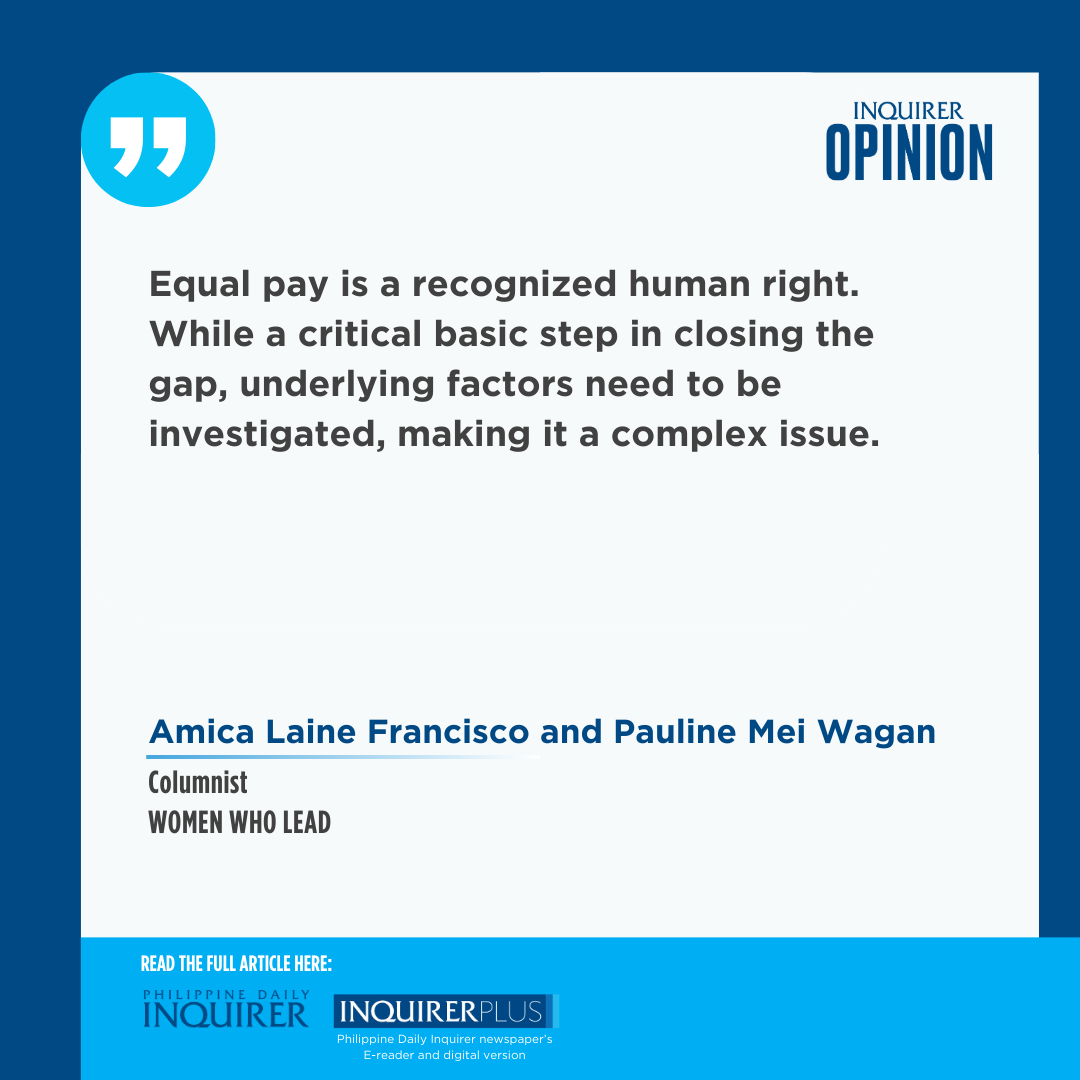Why the gender pay gap persists
Over our consultations with the private sector, we at the Philippine Business Coalition for Women Empowerment (PBCWE) noticed a pattern: Many believe that a gender pay gap does not exist simply because pay is merit-based nowadays. Men and women with the same position and rank are now paid the same rate according to performance.
But contrary to popular belief, the gender pay gap is not solely measured by equal pay for equal work. What drives it are other pressing issues like gender roles and biases affecting women’s labor force participation. The fact stands that no country has closed the gender pay gap. While significant strides have been made, the Global Gender Gap Report 2024 reveals that it will take more than 100 years to reach full gender parity, especially when it comes to pay equity. United Nations studies also show that women are still paid 20 percent less than men globally.
On Sept. 18, as we celebrate “International Equal Pay Day,” let us be reminded of our global commitment to end gender pay disparity. Equal pay is a recognized human right. While a critical basic step in closing the gap, underlying factors need to be investigated, making it a complex issue.
Occupational bias and trends. Gender norms can perpetuate the gap, among them occupational segregation, a worldwide trend pertaining to the unequal distribution of men and women across and within job types. Men dominate industries such as energy and construction, while women are concentrated in the health and education sectors. This can mean disparities among higher-level positions, which are possibly influenced by beliefs and biases that affect recruitment and promotion. Safety and mobility concerns can also contribute to segregation.
Women, too, have to carry the burden of unpaid care work, and, thus, incur what may be considered “child and motherhood” penalties. This stems from societal expectations that women should devote more time to care responsibilities than men, a disadvantage women face for having children. The disproportionate burden of care work causes career setbacks and continuously hinders women’s full participation in the labor force.
Glass ceiling and leaky pipeline. The glass ceiling and leaky pipeline are phenomena that prevent women from reaching leadership positions, especially in male-dominated industries. Systemic barriers, lack of flexibility, and limited mentorship contribute to these challenges. From our recently launched study on the “Census on Women in Executive Leadership Teams in Publicly Listed Companies,” we learned that women’s representation in leadership positions has increased in recent years. Yet, most women still occupy functional roles rather than line roles, the latter being essential in advancing to higher positions.
On Sept. 28, the PBCWE is one with the world in celebrating the International Day for Universal Access to Information. We recognize that such access is a privilege that underscores the importance of data in supporting Philippine workplaces to thrive. We help companies navigate their workplace gender equality journey through the gender equality, assessment, results, and strategies. This assessment helps firms understand their current gender equality and diversity situation, and identify areas for improvement by establishing baseline information.
From information into action. Baseline information helps track progress and evaluate outcomes. We focus on areas like gender pay gap, flexible work, and workforce composition. To address gender pay gap, we usually recommend: 1) conducting pay gap audits with a gender lens; 2) developing policies emphasizing inclusive pay, and 3) communicating gaps for transparency.
Through our discussions with stakeholders, we also found that it’s good to have this outlook in eliminating the gender pay gap: While meritocracy is great, fostering an inclusive organization and providing equitable access to opportunities can help in equalizing the meritocracy field.
So, does the gender pay gap persist or is it a controversial take?
We believe that this pay gap is a persistent divide, a lingering truth even in today’s progressive times. It is also an intergenerational systemic issue deeply rooted in biases and discriminatory practices, and an indicator of failure to realize women’s rights to opportunities and potential economic contributions. Intertwined with advocating for gender pay equity is promoting access to right information—a cornerstone of progress helping us make evidence-based decisions.
While it raises awareness, it also has the power to exacerbate issues and widen gaps if not used properly, such as in cases of misinformation now that we are ushering in the digital era. Addressing the divide is both a moral imperative and an economic necessity to induce sustainable growth and social justice.
—————-
Amica Laine Francisco and Pauline Mei Wagan lead the monitoring, evaluation, and learning efforts of PBCWE.
—————-
Women Who Lead is an initiative of PhilWEN.





















